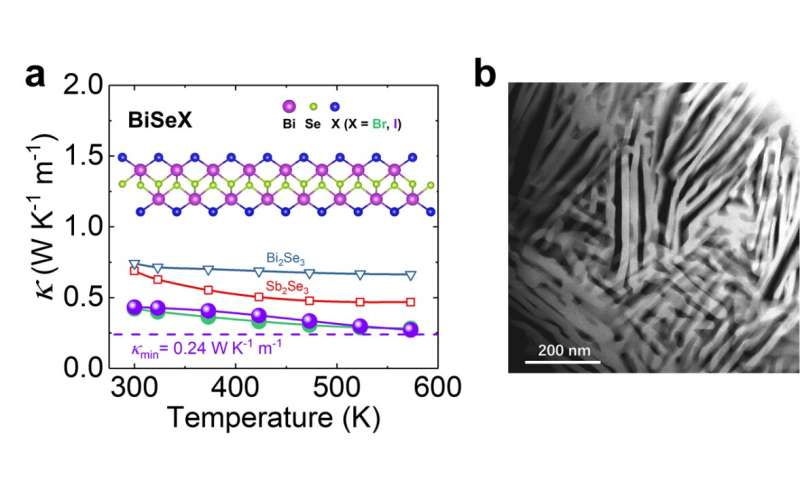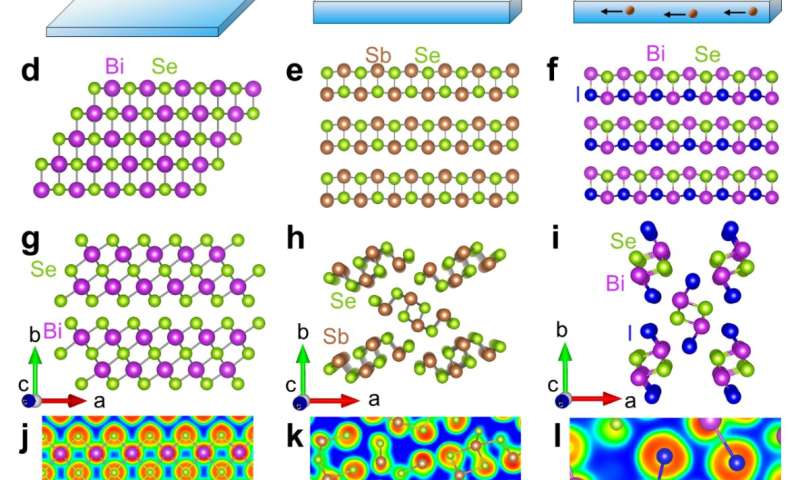#Extremely low thermal conductivity in 1-D soft chain structure
“#Extremely low thermal conductivity in 1-D soft chain structure”

Researchers have reported a new type of simple one-dimensional (1-D) crystal structured bismuth selenohalides (BiSeX, X = Br, I) with extremely low thermal conductivity. Investigations on crystal structure reveal that the ultralow thermal conductivity is due to the weakened chemical bonding in the low-dimensional structure, showing a quasi-0-D crystal structure. These findings provide a novel selection rule to search low thermal conductivity materials with potential applications in thermoelectrics and thermal barrier coatings.
The low thermal transport properties are important for applications in thermoelectrics and thermal barrier coatings. Today, the strategies to acquire low thermal conductivity in bulk materials include multi-scale defect (atomic, nano- and meso-scale), heavy molecular weight, complex crystal structure, larger unit cell and strong anharmonicity.
In a recent article in Science China Materials, Prof. Li-Dong Zhao from Beihang University and co-workers proposed a new strategy to search intrinsically low thermal conductivity in one-dimensional crystal structure. By using the first-principles calculations and experimental synthesis, they found a type of material with extremely low thermal conductivity, BiSeX (X= Br, I) with a one-dimensional chain structure. The mechanisms behind the low thermal conductivity were revealed from the aspect of crystal structure by neutron powder-diffraction measurements and temperature tunable aberration-corrected scanning transmission electron microscopy (STEM).
To elucidate the origins of ultralow thermal conductivity, the authors made comparisons with several analogs that exhibit cubic- (3-D), layer- (2-D) and chain-like (1-D) crystal structures, and found that the thermal conductivity showed a decreasing trend from 3-D, 2-D to 1-D due to the chemical bonding strength between the low-dimensional structure becoming progressively weaker and weaker.

“Based on these guidelines, we found that the chemical bonding along the chain further weakened with added halogen atoms,” said Prof. Zhao. Therefore, the chemical bondings of BiSeX along all three crystallographic directions are weaker than in other compounds, showing a quasi-0-D crystal structure.
Different from the ultrahigh thermal conductivity diamond (> 2000 W m-1 K-1) with strong covalent bonds between carbon atoms, the phonon transport in bismuth selenohalides was significantly suppressed. As a result, they exhibit extremely low thermal conductivity. “The thermal conductivity of BiSeI at 573 K reaches ~0.27 W m-1 K-1, which is close to the theoretical minimum value,” said Prof. Zhao.
These findings open up the prospect of achieving low thermal conductivity materials in a one-dimensional chain-containing bulk structure with potential applications in the fields of thermal barrier coatings, thermoelectric materials, etc.
More information:
Dongyang Wang et al, Extremely low thermal conductivity from bismuth selenohalides with 1D soft crystal structure, Science China Materials (2020). DOI: 10.1007/s40843-020-1407-x
Extremely low thermal conductivity in 1-D soft chain structure (2020, June 22)
retrieved 22 June 2020
from https://phys.org/news/2020-06-extremely-thermal-d-soft-chain.html
This document is subject to copyright. Apart from any fair dealing for the purpose of private study or research, no
part may be reproduced without the written permission. The content is provided for information purposes only.
If you want to read more Like this articles, you can visit our Science category.
if you want to watch Movies or Tv Shows go to Dizi.BuradaBiliyorum.Com for forums sites go to Forum.BuradaBiliyorum.Com




